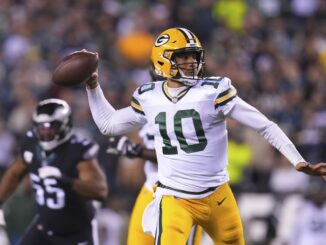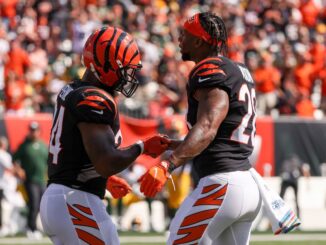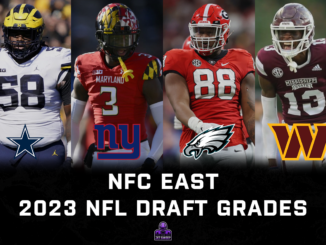
The Philadelphia Eagles’ offense has been on fire this season. As things stand, they sit at 12-1 and rank second in offensive DVOA, behind only the Chiefs. What makes this unit so impressive is their ability to beat their opponents in a variety of ways. Jalen Hurts can dice you up through the air, but they are equally capable of leading with their running game.
They have a varied and diverse playbook to call from, but there is one play that opposing defenses have been utterly unable to stop through recent weeks – Counter. The Eagles run a number of different variations of Counter and all of them have seen genuine success.
So, what is Counter? And how have the Eagles been using it? Let’s dive into the film and find out.
What is Counter?
Counter is a play that has been run at every level of football for decades. Legendary Nebraska head coach Tom Osborne is credited with its invention as part of his hugely successful I-formation offense. The Counter run was then popularised in the NFL by Joe Gibbs and his “Hogs” in Washington, who used it to help them win three Super Bowls.
There are plenty of variations of counter (more on that later), but at its core there is one simple defining feature. Counter always features two offensive players pulling across the formation to the opposite side. In the example below taken from Bill Snyder’s Kansas State playbook it shows the backside guard and tackle pulling across the formation.

The responsibilities of the pullers are fairly simple too. The first puller (usually the backside guard) is responsible for blocking the end man on the line of scrimmage (EMOL). The second puller will then look to climb to the second level to block the playside linebacker.
Counter is a “gap” run, meaning that the ball carrier is always aiming for a specific gap. On counter, they are told to follow the second puller up to the second level. Timing is crucial on Counter – the ball carrier needs to be patient and wait for his blocks to develop, before quickly following them to the second level.
The numbers
Before we dive into the film, it is worth looking into how the Eagles have been using Counter. Below is a quick breakdown of their production on Counter compared to other designed rushing concepts since Week 11:
| Rush concept | Production |
| Counter | 28 carries, 218 yards (9.1 ypa), 2 TDs |
| Non-Counter | 129 carries, 700 yards (5.4 ypa), 8 TDs |
Most teams would kill for a running game as productive as the Eagles’ non-Counter runs, but their success at running Counter has been something else. They are averaging a frankly ridiculous 9.1 yards per attempt. For context, that is far more productive than the league’s best passing attack (Miami at 8.3 yards per attempt).
One of the reasons their Counter plays are so difficult to defend is the number of different variations they have. Avoiding obvious tendencies keeps opposing teams guessing and keeps the advantage firmly on the Eagles’ side. With that in mind, let’s look at three of the ways the Eagles have run Counter this season.
GT Counter Read
GT Counter is probably the most popular form of Counter. The “GT” part refers to the pulling blockers, with the “G” referring to the backside guard, and the “T” referring to the backside tackle. The Eagles actually rarely run a traditional version of GT Counter. Instead, they add a read option into the play, hence the name “GT Counter Read”.
You can see how it works to great effect on the play below against the Packers. The Eagles leave the backside edge defender unblocked and treat him like they would on a conventional read option play. If he crashes down to stop the counter, Hurts can hand the ball off and the running back has tonnes of space to exploit. If he hesitates, Hurts will keep the ball and follow the pulling blockers.
The read option element also allows the Eagles to run Counter out of less traditional formations. Normally in Counter you need a fullback or tight end to pick up the backside edge defender. If you don’t, there is nothing to stop him blowing up the play, as both the guard and tackle to his side have vacated their space. By adding the option element, the Eagles can take the edge defender out of the play without having to assign an extra blocker.
The play below against the Giants is the perfect example of that. This time they are running it from a split back formation and use the option run to Miles Sanders to freeze edge rusher Azeez Ojulari (#51). Ojulari has to honour the threat of Sanders, which allows Hurts to keep the ball and follow his pullers once again for a nice gain.
CT Counter Empty
Sometimes the Eagles will run Counter without the read option element. Where this differs from traditional read option plays is that they will often use Jalen Hurts as the designed runner. Even more unusual is that they will do this without the help of any inline tight ends. The fact they don’t need the extra help is a testament to the talent of this offensive line and Hurts as a runner.
They used this play in the red zone against the Giants and came away with a touchdown. You will notice a few slight differences here. For starters, they use center Jason Kelce as the first puller instead of the backside guard. This time they also ask the playside tackle to block the EMOL. That allows the two pullers to both climb to the second level.
This means that edge rusher Kayvon Thibodeaux is left unblocked on the left side of the line. In reality it doesn’t matter, as Hurts is too quick and the blocking is too good for Thibodeaux to do anything. Hurts waltzes untouched into the endzone for a touchdown.
GY Counter
When the Eagles faced off against the Giants in Week 14 they leant into their ground game. Miles Sanders finished the game with an eye-popping stat line, carrying the ball 17 times for 144 yards and two touchdowns. That works out at an unbelievable 8.5 yards per carry.
If you are wondering how they did that, look no further than this play – GY Counter. All told, the Eagles ran the play no fewer than nine times against the Giants. As you can tell by the name, this is another different variation. It still has the backside guard pulling, but instead of the tackle, they use a tight end – hence “GY” counter.
Their favourite way of running this is from a “Nub” formation. In simple terms, this sees the three other eligible receivers line up to one side of the field, whilst the tight end aligns inline on the other side. That gives them an extra inline blocker to the playside to seal off the second level defenders.
You can see how it all works to brilliant effect on this play against the Giants. Left guard Landon Dickerson does an excellent job of pulling and walling off the edge defender. Miles Sanders then shows the patience to follow his lead blocker, tight end Grant Calcaterra. Not a single Giants defender gets a hand on Sanders, who scampers for a 40-yard touchdown.
What makes this play so impressive is that even when the defense does everything right, the Eagles still end up winning. Take this play, again from the Giants game. New York started to get wise to how much the Eagles were running this play, and did everything they could to stop it. You can see as much by watching their two linebackers. As soon as Hurts snaps the ball, they know what is coming and fire downhill to try and beat the pullers and blow up the play.
It doesn’t end up mattering one bit. Both of them are overwhelmed by the offensive linemen climbing to the second level, leaving Miles Sanders untouched once again and free to hit the second level for a 14-yard gain.
The Eagles have the best running game in football and it is easy to see why. The variety of their rushing attack, coupled with the overwhelming talent advantage is almost impossible to stop. Counter is the jewel in that crown and has played a key role in their success so far this season. You can certainly expect to see a lot more of it as the season continues.


